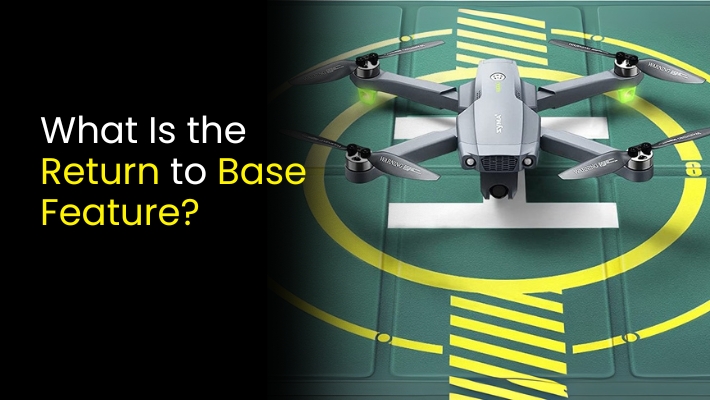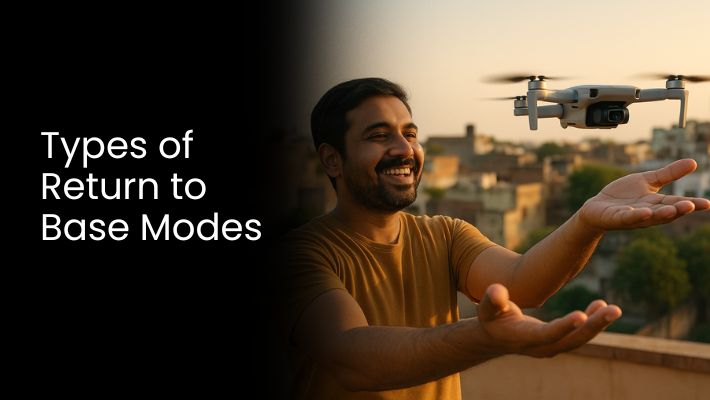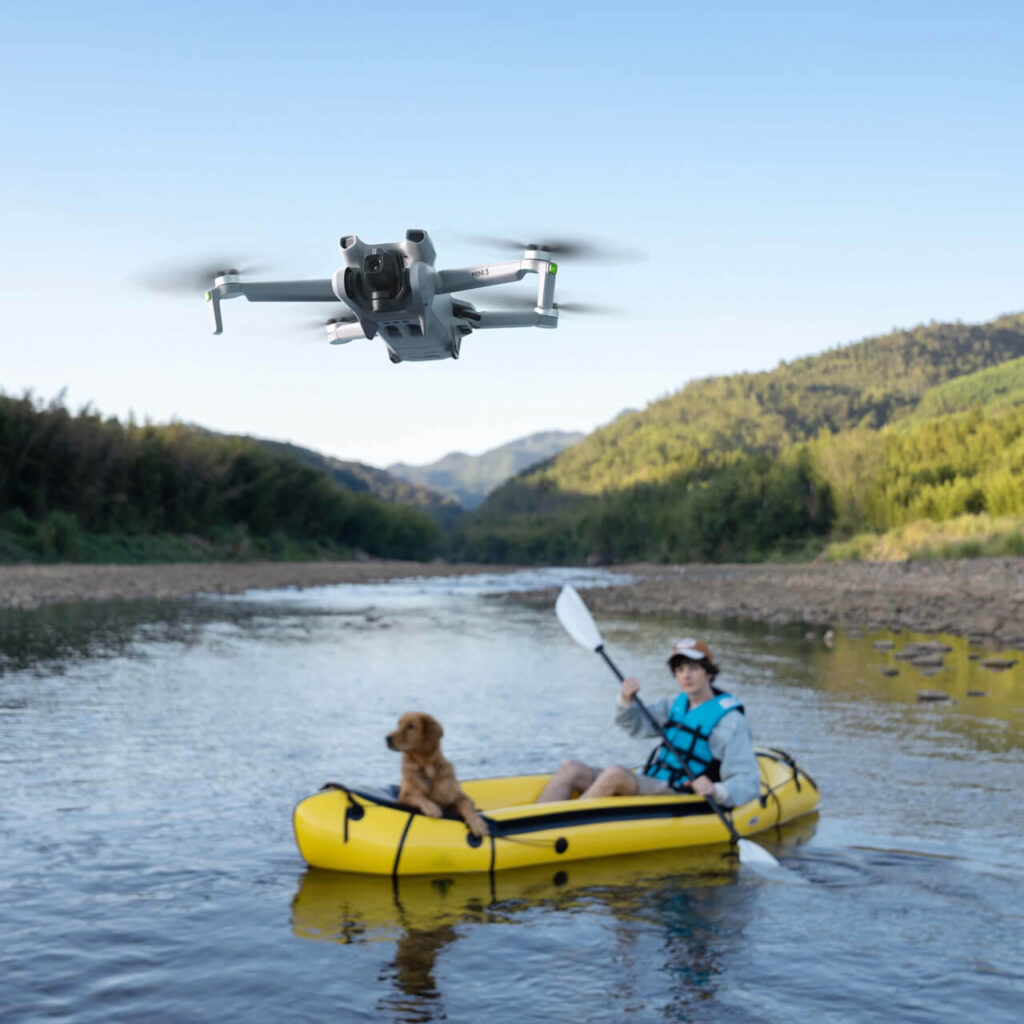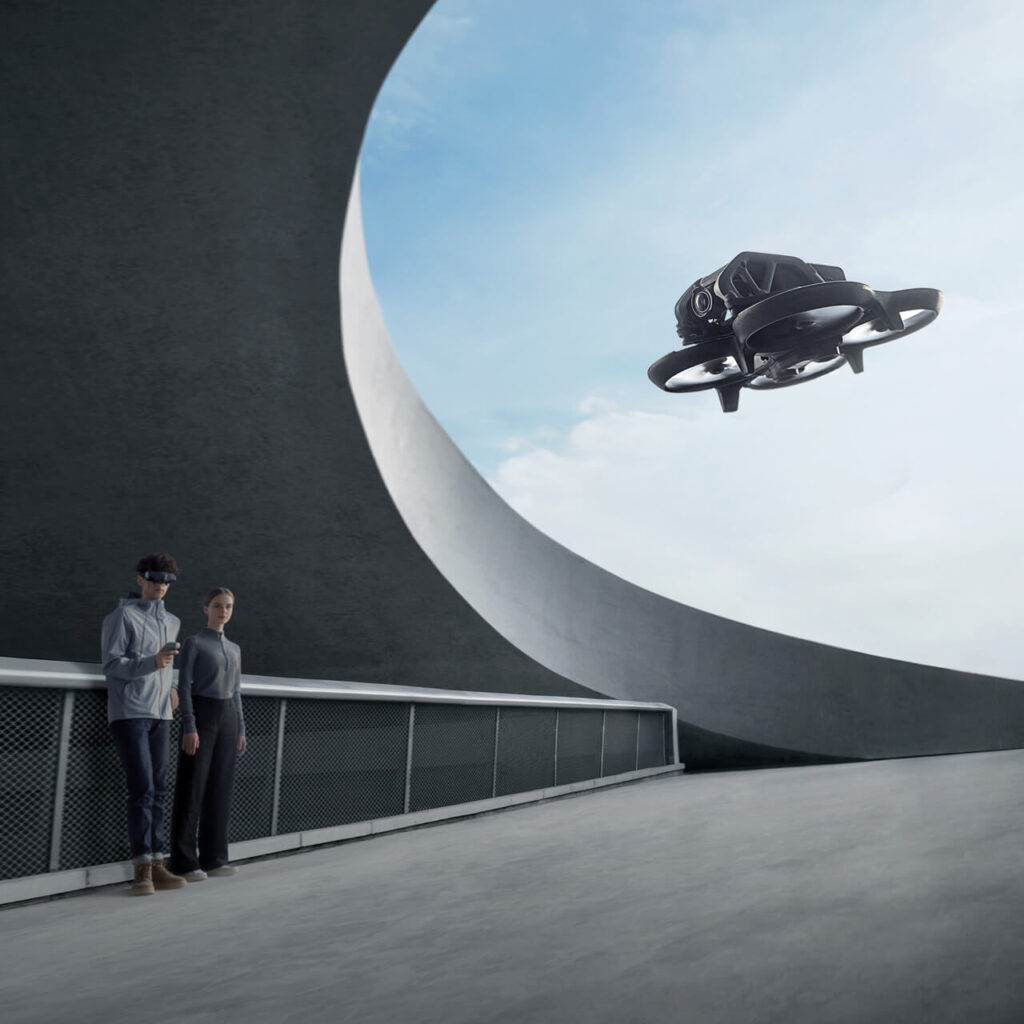Drones are no longer just hobbyist gadgets. They’ve become essential tools in industries ranging from agriculture and construction to surveying, filmmaking, and defense applications. With this growing demand, one thing buyers consistently look for is safety and reliability. After all, a drone is an investment, and losing it mid-flight can mean financial loss, project delays, or even safety risks.
That’s where the Return to Base (RTB) feature becomes a game-changer. Simply put, RTB allows a drone to automatically navigate back to its launch point or a designated safe spot whenever something goes wrong. It could be a low battery, sudden weather change, loss of GPS signal, or even a pilot error the drone knows how to find its way back without manual intervention.
At Jetayu Gadgets, we understand how important this feature is for both beginners and professionals. As a leading seller of drones from top global brands like DJI, Autel, IdeaForge, Enzo, Parrot, and Skydio, we see a clear trend: buyers increasingly ask about the Return to Base feature before making a purchase. Many of the drones we provide whether compact consumer models or enterprise-grade solutions come equipped with advanced RTB modes designed to prevent accidents and ensure safe landings.
For hobbyists, RTB provides confidence to fly without constant worry. For businesses, it ensures projects continue smoothly without unexpected interruptions. And for industries like agriculture or mapping, where drones often cover large areas, RTB is nothing less than a lifesaver for your equipment and data.
In this blog, we’ll dive deep into:
- What the Return to Base feature actually does
- How it works in different drone models
- Why it should be a top priority when buying a drone
- Which drones with RTB you can find at Jetayu Gadgets
- Key buying tips for beginners and professionals
By the end, you’ll have a clear understanding of why every drone buyer should care about the Return to Base feature and how it can influence your next purchase decision.
What Is the Return to Base Feature?

The Return to Base (RTB) feature is one of the smartest safety functions built into modern drones. At its core, it allows the drone to automatically fly back to its starting point or a pre-defined safe location if something goes wrong.
This can be triggered by:
- Low battery: When the power drops below a safe level.
- Signal loss: If the connection between the drone and controller breaks.
- Emergency override: When the pilot manually presses the RTB button.
- Geofencing limits: If the drone moves beyond the allowed flying boundary.
How It Works
The feature combines GPS navigation, onboard sensors, and flight control algorithms to retrace the safest path back. In advanced drones, you can even customize whether RTB should land at the exact take-off point, a “home point” you set in the app, or hover until you take manual control.
For example, DJI’s consumer drones like the Mini series already come with intelligent RTB settings. If you’re still choosing between entry-level models, you may want to read our comparison on DJI Mini 3 vs. Mini 4 Pro Which Combo Is Right for You? to see how RTB and other safety tools differ.
Why It Matters for Beginners
New drone pilots often worry about crashing or losing their device on the very first flight. With RTB, even if you lose track of the drone, it knows how to come back. That’s why in our earlier guide, Worried About Crashing Your First Drone? Here’s Why DJI’s Safety Features Have Your Back, we highlighted RTB as one of the must-have protections for first-time flyers.
Why It Matters for Professionals
If you’re a content creator, RTB ensures uninterrupted shoots and protects your equipment. In fact, many creators we’ve spoken to often ask if just buying a drone is enough to start their journey. Our post on Is Buying a Drone Enough to Start My Journey as a Content Creator? dives deeper into how features like RTB play a role in building confidence.
For commercial operators, rules also come into play. Many countries, including India, require drones to have safety features like RTB for compliance. If you’re unsure of where you stand, check out our breakdown on Can I Fly My Drone Freely or Do I Need a License? Understand the Rules.
Peace of Mind for All Buyers
At Jetayu Gadgets, we often see first-time buyers walk in with doubts should they trust a small drone to come back safely? The answer is yes, provided you choose the right model. For many, the DJI Mini 4 Pro has been the gateway into flying confidently, thanks to its strong RTB and obstacle avoidance systems.
Types of Return to Base Modes

Not all Return to Base systems work in the same way. Depending on the drone model and brand, you’ll find different RTB modes designed for specific situations. Knowing these can help you choose the right drone for your needs.
1. Smart Return to Base
This is the most common mode in consumer drones. At the press of a button, the drone uses GPS navigation to fly back to its take-off location or a pre-set “home point.” It’s especially useful when you’ve flown far and don’t want to manually retrace the path.
If you’re comparing models, our review of Buying a Drone for the First Time? The DJI Mini 4 Pro Makes It Easy to Fall in Love with Flying highlights how Smart RTB makes this compact drone beginner-friendly.
2. Low Battery Return to Base
When the battery drops below a safe threshold, the drone automatically calculates whether it has enough charge to return. If not, it initiates RTB to prevent a crash landing.
For frequent flyers, especially travelers or vloggers, this feature is critical. We’ve covered the importance of flight safety in our guide Touch the Sky. Capture Your India from the Himalayas to the Sea with Your Drone, where long-distance flights require reliable RTB backup.
3. Failsafe Return to Base
If the drone loses its connection with the remote controller due to interference, long distance, or obstacles it switches to Failsafe RTB and returns on its own.
This is a must-have for professionals filming solo adventures or travel vlogs. In our post Vlogging Your Solo Adventure? Here’s What Only a Drone Can Film, we explain how Failsafe RTB lets you focus on your story while the drone handles safety in the background.
4. Advanced RTB with Obstacle Avoidance
High-end drones like the DJI Mavic or Autel EVO series don’t just fly back in a straight line. They use sensors to avoid trees, poles, or buildings on the way home. This advanced mode is vital for urban flying and complex environments.
If you’re curious about how drone weight, size, and safety features tie together, our post on Why Your Drone’s Weight Decides What Rules You Follow explores regulations that often require features like advanced RTB.
5. Customizable Return Points
Enterprise drones, such as those from IdeaForge or DJI’s Matrice series, allow operators to set multiple safe return points. This is valuable in agriculture or construction projects where operations cover large areas.
For professionals considering commercial work, our guide Thinking of Buying a Commercial Drone? Here’s What You Need to Know First dives into why customizable RTB is essential for serious operations.
Why the Return to Base Feature Matters for Different Buyers
The Return to Base (RTB) feature isn’t just a “nice-to-have.” Its importance varies depending on the type of user. Understanding this can help you choose the right drone from Jetayu Gadgets, whether you’re a beginner, content creator, or commercial operator.
1. Beginner Drone Pilots
For first-time flyers, RTB provides peace of mind. It reduces the risk of losing or crashing your drone due to human error or unexpected obstacles. Beginners often wonder if buying a drone is enough to start flying confidently our guide Is Buying a Drone Enough to Start My Journey as a Content Creator? explains how features like RTB play a key role in building confidence.
Models like the DJI Mini 4 Pro or DJI Mini series combine compact design with Smart RTB, making them ideal for those new to flying. For more on beginner-friendly drones, see Buying a Drone for the First Time? The DJI Mini 4 Pro Makes It Easy to Fall in Love with Flying.
2. Content Creators & Vloggers
For creators, RTB ensures that your drone safely returns during long shots or complex aerial movements. It allows you to focus on cinematic capture rather than constantly monitoring the drone.
If you’re capturing solo adventures or scenic locations, check Vlogging Your Solo Adventure? Here’s What Only a Drone Can Film. Smart RTB lets you fly farther with confidence, knowing your drone can automatically return if needed.
Travel vloggers will also benefit from RTB when navigating unfamiliar environments. Our guide Touch the Sky. Capture Your India from the Himalayas to the Sea with Your Drone illustrates how safety features like RTB expand creative possibilities.
3. Commercial Operators
For professionals in agriculture, construction, surveying, or mapping, RTB is essential for operational efficiency and asset protection. Drones covering large areas often face low battery or signal interference issues, and automatic return ensures data and equipment are not lost.
For agriculture-specific applications, see How Agriculture Drones Are Transforming Indian Farms: A Guide to the Top Models in 2025. In construction, drones with RTB reduce the risk of accidents and complement ground surveys, as highlighted in Why Builders Now Trust Drones More Than Ground Teams for Site Surveys.
4. Regulatory Compliance & Safety
Some drone operations are bound by laws requiring safety features like RTB for commercial or long-range flights. Features such as low-battery RTB and Failsafe RTB are often part of compliance checks.
If you’re unsure about regulations, our post Can I Fly My Drone Freely or Do I Need a License? Understand the Rules provides a clear breakdown of legal requirements in India. Additionally, Why Your Drone’s Weight Decides What Rules You Follow explains how drone specifications can affect the use of safety features like RTB.
Key Takeaway
No matter your experience level, the Return to Base feature is a cornerstone of drone safety and reliability. At Jetayu Gadgets, all drones from DJI and Autel to Skydio and IdeaForge come with versions of RTB tailored to beginner, creator, and professional needs. Choosing a drone with this feature ensures you can fly with confidence and focus on your mission rather than worrying about losing your investment.
Benefits of Using Drones with Return to Base Feature
The Return to Base (RTB) feature is more than just a safety tool it delivers tangible benefits for every type of drone buyer. Here’s why it’s considered a must-have feature:
1. Enhanced Safety and Risk Reduction
RTB drastically reduces the chances of losing your drone due to battery drain, signal loss, or pilot error. This is especially useful for beginners flying compact drones like the DJI Mini series, which we’ve compared in DJI Mini 3 vs. Mini 4 Pro Which Combo Is Right for You?.
2. Peace of Mind for Content Creators
Creators can focus on capturing cinematic shots without worrying about losing the drone mid-flight. For tips on shooting confidently, see How to Set Up Your DJI Drone for Cinematic Shots: Settings, Tips, and Shooting Styles.
3. Operational Efficiency for Professionals
In agriculture, construction, or mapping, RTB prevents equipment loss and ensures smooth project workflow. For agricultural applications, check How Agriculture Drones Are Transforming Indian Farms: A Guide to the Top Models in 2025. For construction, see Why Builders Now Trust Drones More Than Ground Teams for Site Surveys.
4. Compliance and Legal Safety
Many drones require safety features like RTB for legal and regulatory compliance. Features like Failsafe RTB or Low Battery RTB help meet these requirements. For guidance on drone laws, refer to Can I Fly My Drone Freely or Do I Need a License? Understand the Rules.
5. Protection of Investment
Drones are costly, and RTB acts as an insurance of sorts by ensuring the device returns safely. Whether you’re buying your first drone or upgrading to models like the DJI Mini 4 Pro, this feature ensures you don’t risk losing your investment.
Key Takeaway
No matter your experience level or use case, RTB adds value by combining safety, convenience, and compliance. Drones sold by Jetayu Gadgets, from DJI, Autel, Skydio, Parrot, and IdeaForge, come with robust RTB capabilities, making them a reliable choice for beginners and professionals alike.
Buying Guide: What to Look for in a Drone with RTB
Choosing a drone with a Return to Base feature requires more than just checking if the function exists. Different drones implement RTB differently, and other complementary features can affect safety, usability, and performance. Here’s what to consider before buying from Jetayu Gadgets:
1. RTB Accuracy and Reliability
Check how precise the RTB system is. Higher-end drones like the DJI Mavic series or Autel EVO drones use GPS and obstacle avoidance to ensure safe returns. For compact beginner-friendly drones, see Which Mini Drone Is Right for You in 2025? Top 10 Models Reviewed for models with reliable RTB.
2. Obstacle Avoidance Capability
Some RTB modes include obstacle avoidance, which prevents the drone from crashing into trees, buildings, or poles on its way back. This is especially important for urban flying or commercial site surveys. Learn more in Why Builders Now Trust Drones More Than Ground Teams for Site Surveys.
3. Battery Life and RTB Threshold
A drone may only initiate RTB when battery levels are sufficient. Ensure the drone you choose has adequate battery capacity to complete the return safely. For travel and long-distance flights, check Touch the Sky. Capture Your India from the Himalayas to the Sea with Your Drone for tips on battery management.
4. App Integration and Customization
Many drones allow you to set custom RTB points, return altitude, and fail-safe behaviors through their apps. DJI drones, for example, offer these features in the DJI Fly App, explained in What Is the DJI Fly App and Why It Matters for Creator.
5. Suitability for Your Use Case
- Beginners: Small drones with simple Smart RTB, like the DJI Mini 4 Pro, are easier to fly.
- Content Creators: Drones with Failsafe and obstacle-aware RTB let you focus on filming.
- Commercial Operators: Enterprise drones like IdeaForge or DJI Matrice series support advanced RTB with multiple return points. For agriculture-specific guidance, see How Agriculture Drones Are Transforming Indian Farms: A Guide to the Top Models in 2025.
6. Brand Reputation and Support
Buying from a trusted seller like Jetayu Gadgets ensures that the drones are genuine, supported, and regularly updated with firmware enhancements that improve RTB performance. For tips on verifying your purchase, see Bought a Drone Recently? Here’s How to Verify If It’s Not Refurbished.
Quick Buying Checklist

Key Takeaway
A drone is only as safe as its RTB implementation. Choosing the right model, features, and brand ensures you enjoy flying without unnecessary risk. Jetayu Gadgets offers a wide range of drones across brands like DJI, Autel, Skydio, and IdeaForge with these features built in, making them suitable for any buyer from beginners to commercial operators.
FAQs About the Return to Base Feature
1. What happens if my drone loses signal during flight?
Most modern drones with Return to Base automatically switch to Failsafe RTB, flying back to the take-off point or designated home location. This minimizes the risk of crashes or lost drones.
2. Does Return to Base work if the battery is critically low?
Yes, drones with Low Battery RTB calculate if there’s enough charge to return safely. If the battery is too low, some drones will land safely at the nearest safe spot to avoid crashes.
3. Can I manually override the Return to Base feature?
Yes. Most drones allow pilots to cancel or pause RTB mid-flight, giving full manual control if necessary. This is useful in complex environments where obstacles or landing conditions vary.
4. Do all drones have Return to Base?
No. While most modern consumer and professional drones include RTB, some entry-level or toy-grade drones may not. Always check the specifications before purchasing.
5. How do I ensure Return to Base works correctly?
To guarantee proper RTB operation:
- Calibrate the compass and GPS before flight
- Set a clear home point
- Keep firmware updated
- Avoid flying in areas with strong interference or poor GPS coverage



